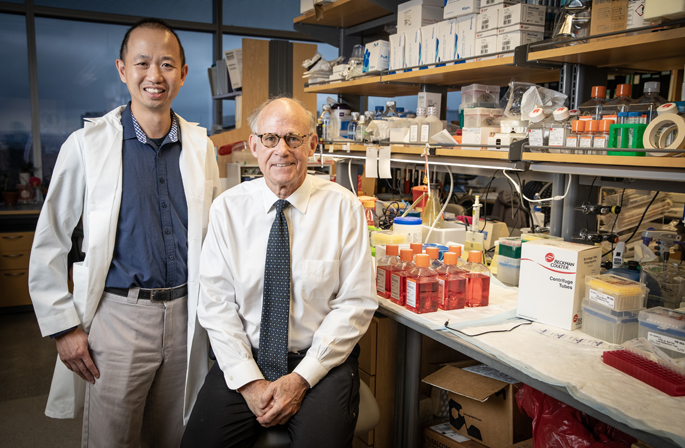
By mapping the cellular and molecular geography of colorectal cancer, Vanderbilt University and Vanderbilt University Medical Center researchers collaboratively have discovered why most colorectal tumors escape detection and destruction by the body’s immune system.
Their findings, reported Dec. 7 in the journal Cell, could lead to new ways to bring these evasive tumors into the harsh and potentially curative light of immunotherapy.
“I’m as excited as I’ve ever been about the treatment opportunities that have been opened up here,” said Bob Coffey, MD, Ingram Professor of Cancer Research at VUMC, who has investigated colorectal cancer for more than 25 years. “We think this is a big deal.”
“This is using next-generation technologies, with data science and AI (artificial intelligence) approaches, to arrive at an outcome that may impact patients,” added Ken Lau, PhD, professor of Cell and Developmental Biology in the Vanderbilt University School of Medicine, Basic Sciences, and the paper’s co-corresponding author.
Second only to lung cancer, colorectal cancer is the nation’s leading cancer killer — accounting for more than 52,000 deaths in the United States each year. Colorectal cancers are divided into two main groups, based on microsatellites, or repeat sections, in their DNA.
Microsatellite-unstable tumors have hypermutated DNA, which generate an abundance and diversity of cancer-specific antigens. These cell-surface markers are easily identified and targeted by roving cytotoxic immune cells, called CD8+ T cells. As a result, microsatellite unstable colorectal tumors are particularly vulnerable to cancer immunotherapy.
“It’s been practice changing, the fact that microsatellite-unstable colon cancer responds to immunotherapy,” said Coffey, also professor of Medicine, and Cell and Developmental Biology, and co-director of the Epithelial Biology Center. “Patients are getting long-term, durable remissions with just immunotherapy.”
However, only 10% of colorectal tumors are microsatellite unstable. The rest are microsatellite stable. Their DNA does not have a hypermutation “phenotype,” and most of them do not respond to immunotherapy, said Lau, also professor of Surgery at VUMC.
To understand why, Lau, Coffey, and their colleagues set out to map the progression of colorectal cancer, from precancerous lesions to malignant and invasive growths, in specimens collected from 31 patients. “There are regions within each tumor that are precancerous, and there are regions that are malignant,” Lau explained.
The researchers took a spatial multiomic approach grounded in next-generation genomics methods refined in the Lau lab. These methods, which included spatial transcriptomics, paired single-cell RNA sequencing, and laser capture microdissection coupled to whole exome sequencing, provided the necessary genetic data to computationally reconstruct tumor progression trajectories.
This was coupled to multiplex immunofluorescence, an imaging technique developed in the Coffey lab that uses fluorescence-labeled antibodies to evaluate cells which constitute the tumor immune microenvironment.
Using a data science approach to map spatial data to tumor progression time, the researchers were able to trace the evolutionary trajectory of the tumors. Cancerous growth followed three main trajectories: as a linear, stepwise progression; a branching evolution characterized by co-existing subclones of cancer cells; and as “big bang” bursts of mutational events.
A key finding was the identification of four genes upregulated in microsatellite stable, but not microsatellite unstable, tumors. The expression of these genes, dubbed the “Immune Exclusion Signature,” impacts the tumor microenvironment in a way that prevents cytotoxic CD8+ T cells from reaching their target.
Three of the genes encode proteins that are secreted from cancer cells and are markedly enriched in extracellular vesicles called exosomes and nanoparticles released from cells called supermeres.
Discovered by Coffey’s lab in 2021, supermeres contain enzymes, proteins, and RNA that are associated with multiple cancers and other diseases. As biomarkers, cancer-associated supermeres could improve diagnosis and therapy.
A clinical trial currently underway at VUMC is testing whether an antibody against one of the gene products, DDR1, will overcome “immune exclusion,” and open the door to the anti-tumor effects of cytotoxic CD8+ T cells and immunotherapy.
“Given the fact that three of these proteins are secreted by cancer cells and can be measured in the plasma, there may be biomarkers at hand,” Coffey said, “and even more importantly, there are agents available that can block them.”
Lau has been working on the cartography of colorectal cancer since he was recruited to Vanderbilt by Coffey in 2013. “It’s been a wonderful partnership,” Lau said.
Cody Heiser, a graduate student in Lau’s lab, is first author of the Cell paper.
Other Vanderbilt University coauthors are Alan Simmons, Eliot McKinley, PhD, Jiawei Wang, Harsimran Kaur, Justin Shao, Naila Tasneem, Zhengyi Chen, William Kim, Andrea Rolong, PhD, Paige Vega, and Nabil Saleh.
Other VUMC coauthors are Frank Revetta, Marisol Ramirez-Solano, Gregory Ayers, Yu Wang, PhD, Sarah Glass, Nicholas Markham, MD, PhD, Simon Vandekar, PhD, Angela Jones, M. Kay Washington, MD, PhD, Joseph Roland, PhD, Qi Liu, PhD, and Martha Shrubsole, PhD.
This study was supported in part by National Institutes of Health grants U2CCA233291 (Human Tumor Atlas Network), U54CA274367 (Translational and Basic Science Research in Early Lesions), R35CA197570, P50CA236733, P01CA229123, R01DK103831, K07CA122451, F31DK127687, and P30CA068485, and by the Nicholas Tierney GI Cancer Memorial Fund.















